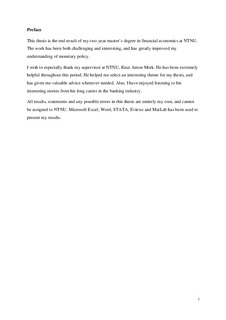| dc.description.abstract | The question whether central banks should emphasize financial stability when setting their policy rate has created an ongoing debate among policy makers and economists since the Global Financial Crisis. In this thesis, I examine whether Scandinavian central banks, with a main focus on Norway, should use monetary policy to support financial stability. In international literature, this type of policy is referred to as “Leaning Against the Wind”. This is done by central banks raising their policy rate above what is necessary for reaching the traditional inflation target and keeping output stable. The general idea is that this policy will benefit the economy through a reduced probability of a financial crisis in the future. But, increasing the policy rate also inflicts costs. In this context, the cost is expressed by an increase unemployment rate in the following period. This strategy is compared to a traditional one where financial stability is not considered.
The thesis begins with an empirical study to discover which financial variables can explain the occurrence of financial crises best. The data material is based on annualized observations from 1870 to 2013. I find lagged real debt growth 5 years before a financial crisis to be the best explanatory variable. As a second step, the result is used in a cost-benefit framework to examine how leaning as a policy affects the welfare in the economies. This is done by using a loss function, consisting of unemployment only. I take advantage of impulse responses from both the Norwegian and the Swedish central banks to investigate how an increase in the policy rate would affect both credit and unemployment. I also estimate these two effects in my own VAR-model to examine how using a different model affect the outcome.
I conclude that Leaning Against the Wind does not appear to be a desired policy for a Scandinavian central bank. The cost of leaning simply outweighs the potential benefits. I also discover that this result is quite sensitive to the assumptions made in the framework, the parameters from the central banks` DSGE models, and the effect of macroprudential policy. Replacing the parameters from the DSGE-models of the central banks to my own VARestimates based on Norwegian data worsened the argument for leaning, making the costs outweigh the benefits even more. The VAR-results implies that leaning has costs due to an increased unemployment rate, but also an additional cost as a total increase in the probability of a financial crisis. | nb_NO |
